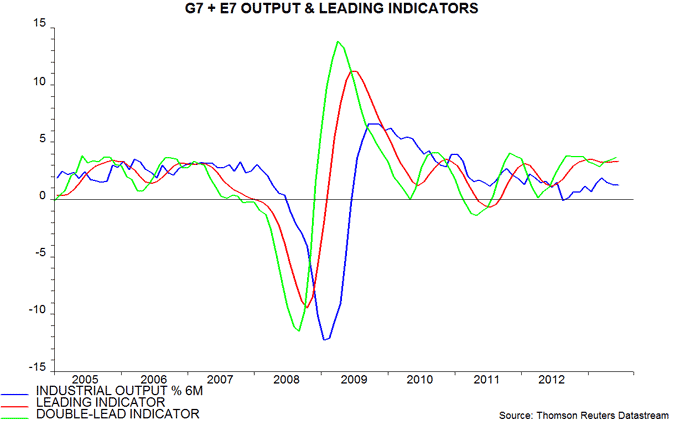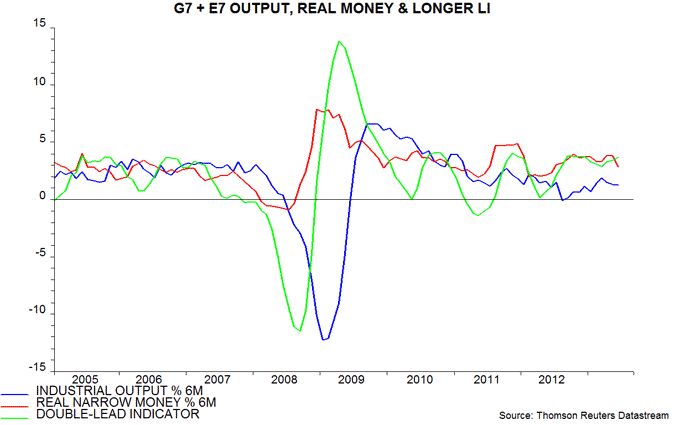Entries from August 4, 2013 - August 10, 2013
Global leading indicators still positive
The forecasting approach here seeks to identify future turning points in the global economic cycle using 1) real narrow money expansion and 2) short- and longer-term leading indicators derived from the OECD’s country leading indices, which combine a range of economic and financial information.
Global real money growth leads turning points in output expansion by about six months, versus recent averages of three and five months respectively for the short- and longer-term leading indicators.
Real money growth and the leading indicators have signalled solid global expansion during the second half of 2013 – see previous post here. June monetary numbers, however, were less upbeat, suggesting that momentum will fade at year-end, as explained in another recent post.
This warning signal has yet to be confirmed by the leading indicators. Both the short- and longer-term measures, indeed, rose in June, according to data released today – see first chart. Economic news, in other words, is more likely to strengthen further than soften through autumn 2013.
The recent renewed rise in the longer-term leading indicator follows an acceleration in real money growth between February and April / May, before the June drop – second chart. Unless this decline is reversed, the odds are that the indicator is at or close to a peak. A fall in July or August would warrant greater concern about an economic slowdown at end-2013.
The suggestion is that economic news will be supportive for equities and other risk assets in the near term. The greater danger for markets is a deterioration in the liquidity backdrop as stronger activity reduces the current excess of global real money growth over output expansion.


UK guidance: rate commitment hinges on questionable productivity rebound
As expected, the MPC has introduced Fed-style policy guidance based on a threshold for the unemployment rate but with inflation and financial stability “knock-out” clauses . The 7% level of the threshold, however, is higher than many commentators predicted, explaining a negative market reaction.
The MPC’s central expectation is that unemployment will remain above the threshold through late 2016 but market participants have given this little weight, partly reflecting the Committee’s poor forecasting record. The view here is that the jobless rate will fall significantly in response to the current growth pick-up, with a breach of the threshold likely by mid-2014 – see previous post.
The table below, taken from the forward guidance documentation, shows illustrative projections for the unemployment rate in three years’ time for different combinations of GDP and productivity growth. The MPC’s central forecast is that GDP will rise by 2.5% per annum over this period. Its expectation that the unemployment rate will be a little above 7%, therefore, assumes that productivity will increase by 1.5-1.75% pa.
Such performance, however, would be stellar by recent standards. Productivity grew by only 1.0% pa in the 10 years to 2012; it was stagnant between 2009 and 2012.
The additional rows at the bottom extend the analysis to allow for weaker productivity performance – their omission from the published table is strange. A growth rate of 1.0% pa in conjunction with the Bank’s forecast of 2.5% GDP expansion would imply an unemployment rate of only 5.5% in three years’ time, versus 7.8% currently. Such a decline would be consistent with it hitting the 7% threshold a year out.
The prospect of an early and significant fall in unemployment suggests that, far from anchoring interest rates far into the future, the new framework will force the MPC to tighten policy sooner than implied by recent time-based guidance.
UK PMIs historically strong: 2013 growth of 2% still achievable
Strong July purchasing managers’ surveys across manufacturing, construction and services support the long-standing expectation here that the UK economy will grow by about 2% in 2013. Forecasters are scrambling to upgrade their predictions but the consensus currently remains well below this level.
Annual average growth of about 2% may be achieved by a combination of upward revisions to current first- and second-quarter estimates and continued solid expansion during the second half, resulting in an increase of about 3% in GDP between the fourth quarters of 2012 and 2013. The four-quarter GDP rise has surged well past 3% when surveys have shown similar strength historically.
This year’s economic pick-up was signalled by increases in annual real (i.e. inflation-adjusted) broad money growth and share prices during 2012. As discussed in a previous research note, joint increases in real money expansion and the stock market usually presage a solid GDP rise in the subsequent calendar year. Falls in both indicators, by contrast, have warned of economic weakness – such a signal was given at end-2011, correctly anticipating poor performance in 2012.
The positive message for 2013 from this simple forecasting rule-of-thumb was reinforced by a strong pick-up in real narrow money around year-end 2012. Narrow money – i.e. M1, comprising sterling notes and coin and instant-access deposits – is accorded significant weight here as an indicator of short-term spending prospects, since consumers and firms usually accumulate such cash holdings before increasing outlays. Six-month growth in real non-financial M1 reached 10.1% annualised in April – the fastest since 2004.
The brightening of economic prospects in late 2012 / early 2013 was missed by an economics consensus that continues to pay little attention to monetary indicators. The average forecast for calendar GDP growth, indeed, was cut further in early 2013 as “triple-dip” hysteria – unsupported by any evidence – took hold. The supposedly-independent Office for Budget Responsibility chased the consensus lower, predicting a 2013 GDP rise of just 0.6% in its March Budget update.
Monetary trends lead the economy by about six months and remained solid in June, suggesting continued robust economic expansion through end-2013 – see previous post.
Current and prospective economic strength argues against the MPC entering a commitment to maintain rock-bottom official interest rates, particularly given evidence that firms are raising prices in response to better-than-expected demand – the PMI services output price index rose to its highest level for more than two years last month. Such a commitment, indeed, could be counterproductive if consumers and businesses think that loose policy in the immediate future will need to be offset by larger rate rises further out – worries about consequent economic weakness could hold back spending now.
An MPC responding to incoming data in the same way as in the past would now be shifting to a mild tightening bias, according to the “MPC-ometer” model followed here – a statistical representation of the Committee’s “reaction function” since its inception in 1997. The model turned positive, suggesting a hawkish majority, in August – the last positive reading was in August 2011. Bank of England Governor Mark Carney may succeed in delivering a new dovish commitment this week but latent opposition from other MPC members could come back to bite him.
